
Ponzano, Italy
projectPPS. Ponzano Primary School
-

-

Night view of the south east elevation, detail
-
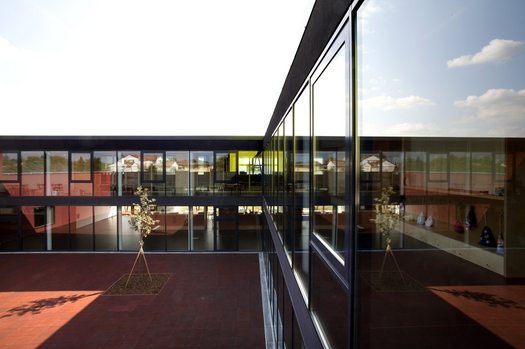
The inner courtyard
-

The south-eastern elevation
-

One of the classrooms
-

The north elevation, detail
-
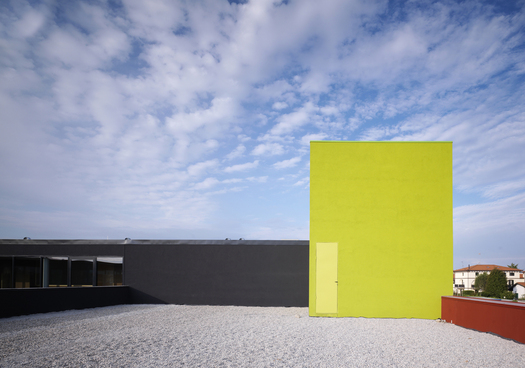
The roof garden outside the art classroom to be used for outside exhibitions
-

View of the courtyard form the inside of the school
-
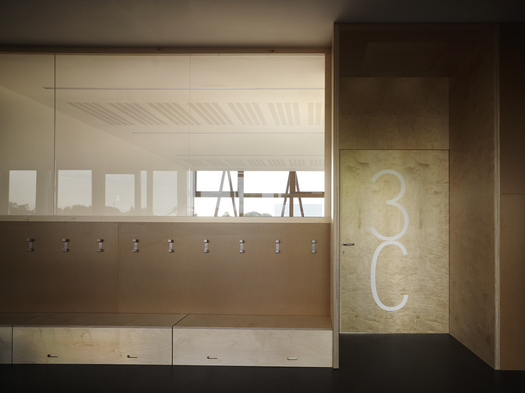
The wood and glass-made classrooms' walls
-

The gymnasium
-

The stairs
-
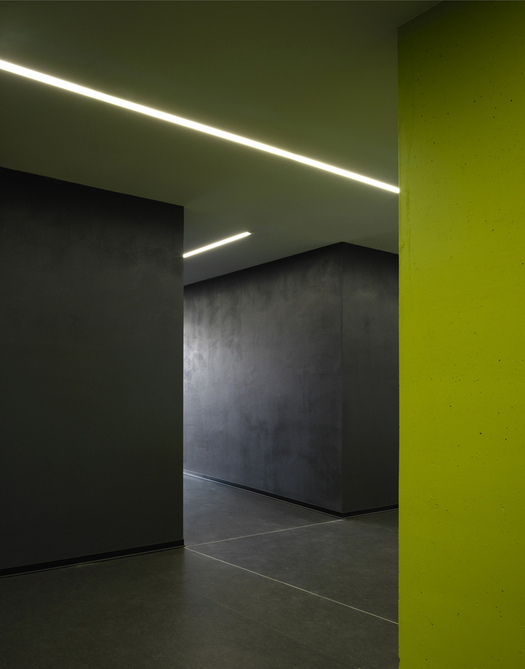
The art, language and computer laboratories
-

Night view of the arcade outside the classrooms
-

Alix and the White Rabbit drawing the school: they sew the roof to the ground with a red thread (Drawing: Roberta Gorni)
-
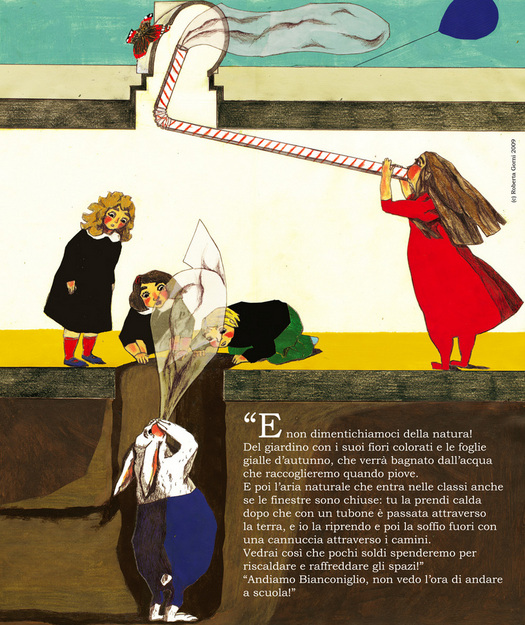
Alix and the White Rabbit drawing the school: the school saves energy (Drawing: Roberta Gorni)
PONZANO PRIMARY SCHOOL: A ‘SOCIETY BUILDING’
Ponzano primary school is a sustainable building in energetic, social and cost control meaning.
Energy: It consumes only 3.6 kWh/mc/year.
Society: participated design phase with children and teachers
Cost control: the cost of the building including furniture is 960 euro/sqm
Ponzano Primary School is designed for 375 children aged from 6 to 10. It has 15 classrooms and special classrooms for art, music, computer, language and science, a gymnasium, a canteen and a library.
Inside the sprawl of the Veneto Region, where Ponzano is settled, this Primary School constitutes a new node, a meeting place for the whole community. Part of the building (the gymnasium and some of the classrooms) is in fact accessible by everybody in the after-school hours.
The school becomes a ‘society building’ where collective spaces are very important. Firstly, in the general outline: all spaces are gathered around a central square, memory of the monastic cloisters (in the common memory they are the places of past knowledge preservation). Then, also in the design of the building's section: all the spaces face each other (though maintaining their specificity like the classrooms which are opaque until cm 130 and glazed above, allowing the children to exhibit their work towards the common spaces) and are reflected by the transparent and coloured walls.
This complexity reminds us the model of the industrial districts in Veneto where people are incited to learn from each other by exchanging experiences.
The school becomes a ‘society building’, a space of possible multietnic exchange and comparison. It becomes a threshold, were to keep together a landscape of memory and a landscape of contemporary.
In this project memory is represented by a remind to cultivation, the red coloured ‘barchessas’ of the Veneto Region. The contemporary is linked to the Benetton factories (which are in the plot nearby) and their culture of good design and philosophy spreading colour democracy all over the world.
In this sense the school design becomes the scenograpy of a dream (of a fairytail would the children say) where the main characters are the children together with their teachers and the comunity around the school.
During the design phase we wrote and illustrated a story with six panels to explain the project to the children and organised a web site (www.nuovascuola ponzano.it) where everybody could find all the materials of the project.
This partecipation activity was followed by visits to the construction site.
The design of the elevation is offered by a thin filigree. It sews together the roof and the ground and transforms the elevation in a deeper threshold designed by the shadows of the red bend pillars on the wood and glass wall inside the arcade where all the classrooms are open towards.
The arcade is also the screen against the sun together with a system of rolling curtains (mounted on a metallic structure) which automatically unroll under the control of the BMS system.
Another design topic is that of intervisibility. We are convinced that children can learn very well also copying one from the other (this is the reason why also the classrooms’ walls are glazed and can easily become windows exposing the children’s works.
Due to his huge volume, the gymnasium has been dag in the ground and natural light is brought inside modelling the ground with new enbankments.
The classrooms where the children spend most of their time face south-east and south-west so as to improve their daylight exposure. Thanks to a judicious orientation, a thick insulation, a green roof and sophisticated technologies (geothermal heating, photovoltaic panels, natural ventilation chimneys, BMS: building automation system) the school consumes only 3.6 kWh/mc/year, reaching the Italian Class A+ efficiency rating with a building cost of only 960 euro/sqm including furniture: a proof that the very strong economic and functional requirements of an educational building are compatible with energetic efficiency and high quality interior spaces.
Awards
Bibliography
R. Fiumara, M. Borgherini, Segni e Modelli, Milano, 2013, pp. 169-178
2.4 MBAA.VV., Ponzano Primary School, in: AA.VV., In Green! Public Architecture, China 2013, pp.160-167
1.8 MBM. Biraghi, Storia dell'architettura italiana 1985-2015, Torino 2013, pp.55, 248, 249, 250, 337, 338
V. Moretti, Progettare l'educazione. A scuola di sostenibilità, in <<Est>> n. 21, 2012, pp. 19-25
1.6 MBF. Ligabò, Scuola da Award, in: <<Nuova finestra>> n. 389, 2013, pp. 66-69
4.7 MBHu Yanli, Chen Zhouyng, European Style, Hong Kong 2013, pp.280-289
7.7 MBC+S-Cappai Segantini, TranslationArchitecture, in: <<IoArch>> n. 46, 2013, pp. 23-32
3.8 MBC. Cappai, M.A. Segantini, PPS. Ponzano Primary School, Nursery School in Covolo di Pederobba, in: AA.VV., 100' X European Architects, Braun, 2012, pp. 971, 985
C.Cappai, M.A. Segantini, LCV. Law-Court Offices in Venice, PPS. Ponzano Primary School, HBB. Harbor Brain Building, in: AA.VV., Gold Medal of Italian Architecture, catalogue of the exhibition, Bologna 2012, pp. 78-83, 138-139, 198-199
5.5 MBAA.VV., School Architecture. Design for Elementary and Secondary Schools, Bejin, 2012, pp. 296-303
1.8 MBS. Bucci, Per un'architettura civile, in: <<Corriere della Sera>> 24.06.2012
2.5 MB- C+S Associati, Esuela elemental en Ponzano Veneto, Treviso, Italia in ‹‹TC CUADERNOS. Temas de Arquitectura››, n. 12, Valencia 2011, pp. 78-89 1.7 MB
- A. Coppa, Progettare con la storia, il paesaggio, la luce in ‹‹Cer Magazine››, n. 29, april 2011, pp. 20-23 1.0 MB
J.Ngao, Top of the class, in: <<Home Journal>> n. 8, 2011, pp. 101-105
1.6 MB- C+S Associati, Ponzano Primary School, in: AA.VV., Impression, Schools, Shenzhen, China 2011, pp. 194-203 1.5 MB
- L. Paolino, M.Cagelli, A.S. Pavesi, Guida alla progettazione degli edifici scolastici, Milano 2011, pp. 204, 209, 227, 260-265, 303-309, 351, 353 1.4 MB
- C+S Associati, Urban Lake Housing in ‹‹TAIWAN ARCHITECT››n. 433, January 2011, pp. 76-81 2.1 MB
- L. Brogialdi, Nella scuola delle meraviglie. La Scuola Elementare di Ponzano: una "barchessa" rossa legata al suolo sa un filo trasparente in ‹‹Est››n. 11, Settembre-Ottobre 2010, pp. 46-54 1.4 MB
- M.A. Segantini, C+S Associati, Treviso, IT in ‹‹Ark››n. 3, Settembre-Ottobre 2010, pp. 6 320 KB
- D.Bonalumi, A scuola con efficienza in ‹‹ProgettoEnergia›› n. 64, Settembre 2010, pp. 42-47 4.5 MB
- AA.VV, Veneto. Architetti e Architetture in ‹‹CityProject›› 2010 1.7 MB
- M. Ruta, Scuola primaria a Ponzano in ‹‹Arketypo›› Ottobre 2010, pp. 44-47 1.4 MB
- E.Lucchi, Pianeta scuola, in ‹‹Modulo›› n. 362 Giugno 2010, p. 525, 530 1.0 MB
- M. Toffolon, Al centro della collettività, in ‹‹ShowRoom›› Luglio-Agosto 2010, pp. 66-69 565 KB
- A. Marzo Magno, Ponzano, la scuola ‹‹10 in condotta›&rsaquo in ‹‹Corriere della Sera›› 16 Settembre 2010, p. 7 2.8 MB
- A. Ciotti, Scuola a Ponzano Veneto, in ‹‹Progetto&Pubblico&rsaquo&rsaquo n. 44, maggio 2010, pp. 58-65 3.0 MB
- P. Pierotti, Il Padiglione Italia. Creatività attenta ai costi in:Il Sole 24 Ore 27 agosto 2010, n. 234, p. 23 539 KB
- M. Calzavara, Globuli rossi, in: AA.VV., AILATI. Riflessi dal futuro, Milano 2010, pp. 70-71, 297-298 2.4 MB
- P. Pierotti, La sfida è creare spazi per comunità flessibili in: Progetti E Concorsi n. 28, 19-24 luglio 2010, p. 2 6.2 MB
- A. Ciotti, Scuola elementare di Ponzano Veneto: society building, in ‹‹OFARCH&rsaquo&rsaquo n. 114, giugno 2010, pp. 122-129
A.Ciotti, Primary school in Ponzano Veneto: a society building, in ‹‹OFARCH&rsaquo&rsaquo n. 114, June 2010, pp. 122-129 2.0 MB - L. Prestinenza Puglisi, School, Ponzano Veneto. C+S associati have designed a school with a low budget and high ambitions in: A10, n. #33, May/June 2010, pp. 42-43 1.5 MB
- AA.VV., Tende "speciali" per una scuola esemplare, in: Frames n. 146, maggio-giugno 2010, pp. 82-85 AA.VV., "Special" sunshades for an exemplary school, in: Frames n. 146, May/June 2010, pp. 82-85 1.7 MB
- AA.VV., Equivivere. Per un’architettura sostenibile, Padova 2010, pp. 172-179 1.9 MB
- G. Santilli, Progetti innovativi, non solo «messa in sicurezza», in <<Il Sole 24 Ore>> n. 72, 14 Marzo 2010, p. 6 379 KB
- F. Irace, Primary School in Ponzano Veneto, in <<Domus>> n. 933, febbraio 2010, pp. 20-26 2.9 MB
- M. Berrini, A. Colonetti, a cura di, GREEN LIFE costruire città sostenibili, Milano 2010, pp. 88-89 691 KB
- M. Favaro, Ha aperto la scuola dei record: risparmi energetici garantiti e vetrate al posto delle pareti, in <<Il Gazzettino>>, 15 Settembre 2009, p. 4 195 KB
- Fe. Cip., La scuola che si paga la bolletta, in <<La Tribuna>>, 11 Settembre 2009, p.21 173 KB
- M. F., Dal prossimo luglio la nuova scuola diventerà realtà, in <<Il Gazzettino>>, 25 Marzo 2009, p.5 1.3 MB
- Fe. Cip., La nuova scuola raccontata con una fiaba, in << La Tribuna>>, 24 Marzo 2009, p.21 1.1 MB
- AA. VV., Nasce la scuola ecologica, in <<Il Corriere del Veneto>>, 4 giugno 2008, p. 7 406 KB
- R. Bon, A Ponzano nasce la scuola del futuro. Via ai lavori della elementare: edificio hi-tech ad alto risparmio energetico. Nell’edificio spazio per 400 bambini in 15 classi, mensa, palestra e auditorium aperto alla cittadinanza. L’opera costerà 5 milioni di euro, in <<
La Tribuna>>, 4 giugno 2008, p. 24 1.5 MB - M. Favaro, Il progetto della nuova elementare un esempio di architettura e design, in <<
Il Gazzettino>>, 4 giugno 2008, p. 7 792 KB - AA. VV., Strumenti finanziari di intervento, in <<Oice>
> supplemento a <<Progetto & Pubblico> > n. 36, maggio 2008, pp. 25-31 1 017 KB - G. De Diana, Costa 5,6 milioni: è la “scuola che ascolta”. Ponzano, un edificio che recepisce i messaggi dei bambini, del paesaggio e della storia locale: questa la filosofia del lavoro degli architetti. Ecco come sarà la nuova elementare del capoluogo: l´opera sta per andare in gara e verrà aperta per l´anno 2009-2010, in <<Il Gazzettino>>, 24 gennaio 2008, p. 8 540 KB
- AA. VV., Ponzano Veneto, dopo Baeza i C+S, in <<Progetti e Concorsi>>, 7-12 gennaio 2008, p. 11 613 KB